Your cart is currently empty!
Tag: Easy Spanish Sentences
-
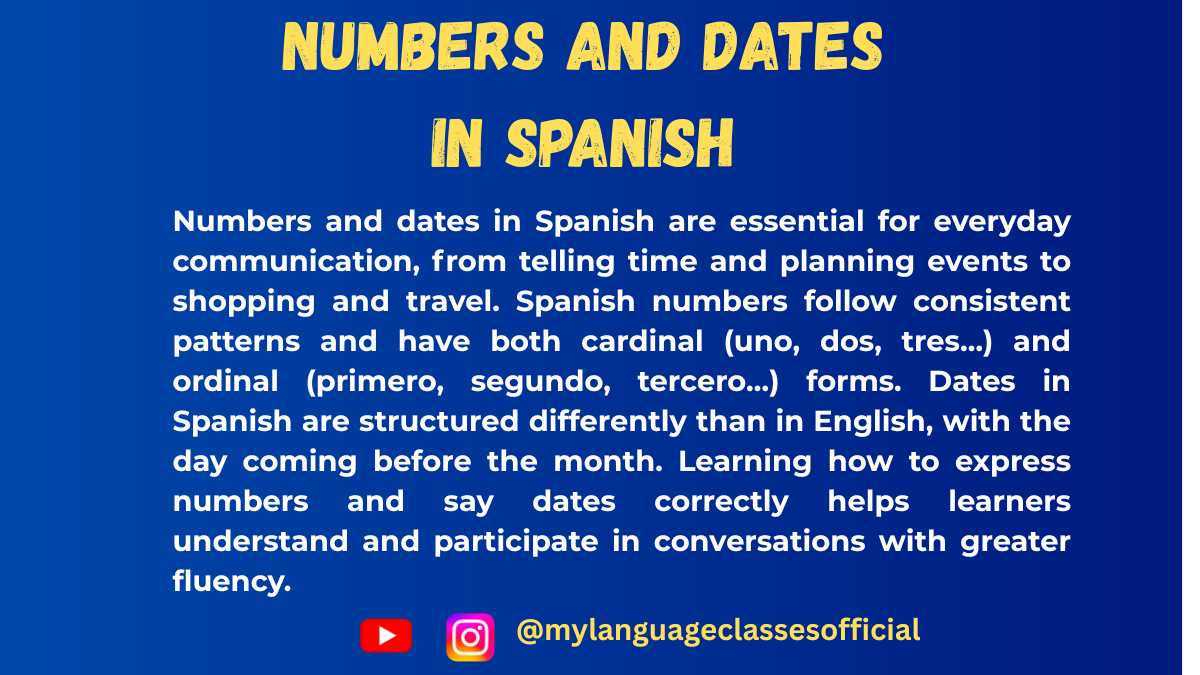
Spanish Numbers and Dates
Learning numbers and dates in Spanish is essential for mastering the language, as they are used daily for everything from making appointments to discussing history. In this blog post, we’ll explore the basics of Spanish numbers and dates, along with tips to practice and use them effectively.
Spanish Numbers: The Basics
Cardinal Numbers
Cardinal numbers (números cardinales) are the most basic form of numbers, used for counting. Here’s a quick overview of the key milestones:- 0-10: Cero, uno, dos, tres, cuatro, cinco, seis, siete, ocho, nueve, diez
- 11-19: Once, doce, trece, catorce, quince, dieciséis, diecisiete, dieciocho, diecinueve
- Tens (20-90): Veinte, treinta, cuarenta, cincuenta, sesenta, setenta, ochenta, noventa
- Hundreds and beyond: Cien (100), doscientos (200), mil (1,000), un millón (1,000,000)
Key Tips for Numbers:
- Pronunciation Practice: Numbers like “cinco” (five) and “siete” (seven) can trip up non-native speakers. Practice listening and repeating them to get the rhythm right.
- Connector for Numbers Over 30: Spanish uses “y” (and) to connect tens and units, e.g., treinta y cinco (35). However, numbers below 30 are written as a single word, like veintidós (22).
Dates in Spanish
Understanding how to talk about dates is vital for everyday conversations. The structure differs slightly from English, so let’s break it down.
The Format
In Spanish, the day comes before the month:
DD/MM/YYYY
For example: 15 de marzo de 2024 (March 15, 2024)Months of the Year
Enero (January), febrero (February), marzo (March), abril (April), mayo (May), junio (June), julio (July), agosto (August), septiembre (September), octubre (October), noviembre (November), diciembre (December)Days of the Week
Lunes (Monday), martes (Tuesday), miércoles (Wednesday), jueves (Thursday), viernes (Friday), sábado (Saturday), domingo (Sunday)Key Tips for Dates:
- Ordinal Numbers: Only use ordinal numbers (e.g., primero for “first”) for the first day of the month. For example, el primero de enero (January 1st). All other days use cardinal numbers: el dos de enero (January 2nd).
- Prepositions: Use de to indicate “of” when saying the full date: el 5 de mayo de 2023.
Practice Makes Perfect
To solidify your understanding of numbers and dates in Spanish, here are some fun activities to try:
- Practice with a Calendar: Choose a calendar in Spanish and try saying the dates aloud.
- Role-Playing Scenarios: Pretend to make appointments or book trips. For example, “¿Qué fecha es hoy?” (“What date is it today?”) or “Mi cumpleaños es el 10 de octubre” (“My birthday is October 10th”).
- Listening Practice: Watch Spanish-language videos or listen to podcasts where dates and numbers are mentioned. Pay close attention to how native speakers pronounce them.
Common Mistakes to Avoid
- Mixing Up Dates: Remember that “3/12/2024” in Spanish means December 3, 2024, not March 12.
- Mispronunciation of Compound Numbers: For example, veintidós (22) is often mispronounced because learners forget the stress on the final syllable.
Learning numbers and dates in Spanish is a rewarding step toward fluency. With consistent practice and attention to the nuances of pronunciation and structure, you’ll be able to confidently use these essential tools in your everyday Spanish conversations. ¡Buena suerte! (Good luck!)
What challenges have you faced with Spanish numbers and dates? Share your experiences in the comments below!
If you enjoyed this lesson, be sure to check out more posts like this on my blog at My Language Classes. Don’t forget to subscribe my YouTube channel and follow me on Instagram for the latest language learning tips and lessons. Leave a comment below to share your thoughts, or ask any questions you have.
Happy learning! 😊
-
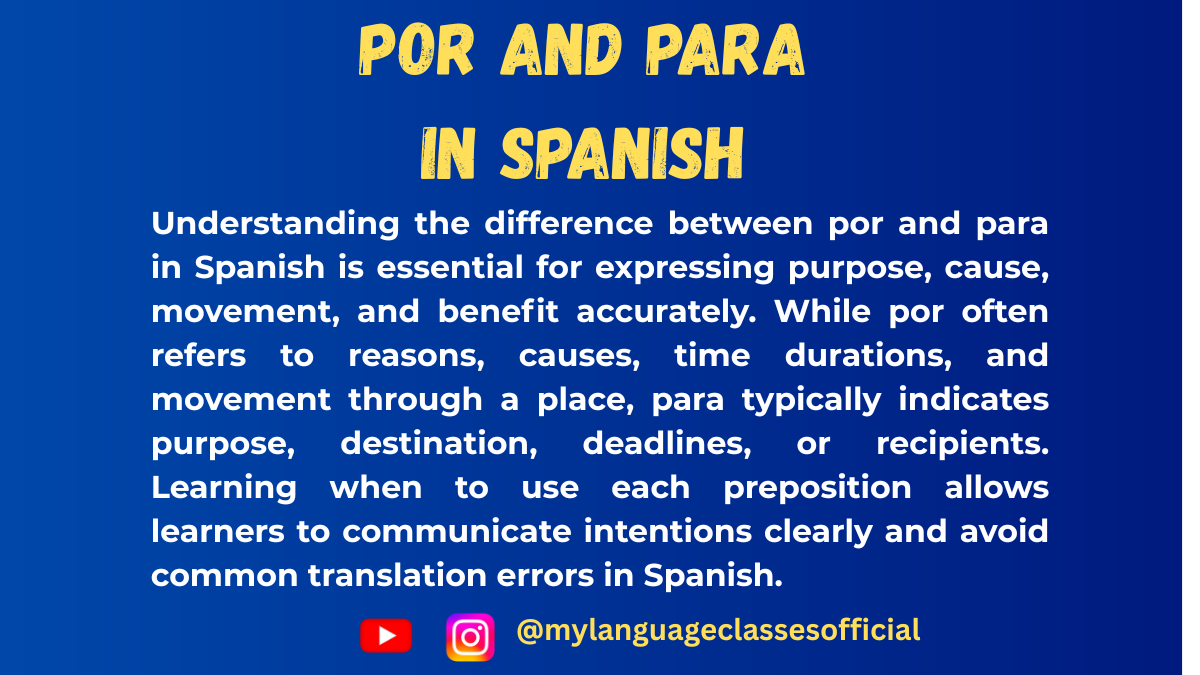
Mastering Por and Para in Spanish
One of the trickiest aspects of learning Spanish is understanding the difference between por and para. While they both translate to “for” in English, their meanings and applications differ significantly depending on the context. In this blog post, we’ll dive into their uses, provide practice questions, share tips for mastery, and conclude with insights to deepen your understanding.
The Basics of Por and Para
- Por: Often indicates cause, means, movement, or duration. Think of it as looking back at reasons or processes.
- Para: Focuses on purpose, destination, or goal. It looks forward to outcomes or effects.
Detailed Uses of Por
- Cause or Reason:
Indicates why something happens.- Por qué llegaste tarde? (Why were you late?)
- Llegué tarde por el tráfico. (I was late because of traffic.)
- Movement Through or Around:
Describes movement in a non-finalized way.- Caminamos por el parque. (We walked through the park.)
- Viajaron por Europa. (They traveled around Europe.)
- Means or Method:
Explains how something happens.- Te llamé por teléfono. (I called you by phone.)
- Mandé el paquete por correo. (I sent the package by mail.)
- Duration or Frequency:
Refers to how long or how often something occurs.- Estudié por tres horas. (I studied for three hours.)
- Voy al gimnasio dos veces por semana. (I go to the gym twice a week.)
- Exchange or Substitution:
Describes a trade or replacement.- Pagué veinte dólares por este libro. (I paid twenty dollars for this book.)
- Cambié mi auto viejo por uno nuevo. (I exchanged my old car for a new one.)
- Expressions of Emotion:
Highlights the cause of a feeling.- Tengo mucho respeto por ti. (I have a lot of respect for you.)
- Lo hizo por amor. (He did it out of love.)
- Idiomatic Expressions:
Learn these as set phrases:- Por favor (Please)
- Por supuesto (Of course)
- Por fin (Finally)
Detailed Uses of Para
- Purpose or Goal:
Focuses on the reason behind an action.- Estudio para ser doctor. (I study to become a doctor.)
- Trabajo para mejorar mi vida. (I work to improve my life.)
- Recipient:
Describes who benefits from an action.- Este regalo es para ti. (This gift is for you.)
- Hice este dibujo para mi mamá. (I made this drawing for my mom.)
- Deadlines:
Indicates time limits or expectations.- El proyecto es para mañana. (The project is due tomorrow.)
- Tenemos que estar listos para las 8. (We need to be ready by 8.)
- Destination:
Specifies where something is going.- Vamos para la playa. (We’re heading to the beach.)
- Salgo para Madrid esta noche. (I leave for Madrid tonight.)
- Opinion:
Used to express perspectives or preferences.- Para mí, es una buena idea. (In my opinion, it’s a good idea.)
- Para él, la tarea es difícil. (For him, the homework is hard.)
- Comparison to Standard:
Highlights unusual or unexpected qualities.- Para su edad, es muy madura. (For her age, she is very mature.)
- Para ser lunes, estoy de buen humor. (For a Monday, I’m in a good mood.)
Por vs. Para: Key Differences
- Time:
- Use por for duration (por tres horas – for three hours).
- Use para for deadlines (para mañana – for tomorrow).
- Movement:
- Use por for movement through a place (por el túnel – through the tunnel).
- Use para for destinations (para el hotel – to the hotel).
- Reason vs. Goal:
- Use por for reasons (por el mal tiempo – because of bad weather).
- Use para for goals (para aprender – to learn).
Practice Questions
- Translate:
- I bought this for my friend.
- We’ll be in Spain for two weeks.
- This book is for studying.
- They canceled the party because of the rain.
- Choose the correct preposition:
- Salgo ___ la escuela a las 7. (por/para)
- Hice esto ___ ti. (por/para)
- Gracias ___ venir. (por/para)
- Identify the context of por or para:
- ¿Por qué lo hiciste?
- Estudio para mejorar mi español.
Tips for Mastering Por and Para
- Think Cause vs. Purpose:
- Use por for reasons (past or present causes).
- Use para for goals or effects (future intentions).
- Visualize the Destination:
- Use para when thinking about a final result or destination.
- Memorize Idioms:
- Learn common expressions like por favor and para siempre.
- Practice in Context:
- Try to create sentences using both words to compare their meanings.
- Take Note of Patterns:
- Some verbs are almost always paired with por or para (e.g., gracias por, trabajar para).
Final Thoughts and Conclusion
Understanding the difference between por and para can feel challenging at first, but with practice, the nuances become clearer. Think of por as reflecting reasons, processes, or exchanges, while para points toward goals, outcomes, and destinations. By focusing on their key differences and practicing regularly, you’ll gain confidence in distinguishing them.
Both por and para are indispensable in Spanish, and mastering them will elevate your fluency. Use the practice questions, keep experimenting with sentences, and don’t shy away from making mistakes—learning a language is a journey of trial and discovery.
¡Buena suerte! (Good luck!)
If you enjoyed this lesson, be sure to check out more posts like this on my blog at My Language Classes. Don’t forget to subscribe my YouTube channel and follow me on Instagram for the latest language learning tips and lessons. Leave a comment below to share your thoughts, or ask any questions you have.
Happy learning! 😊
-
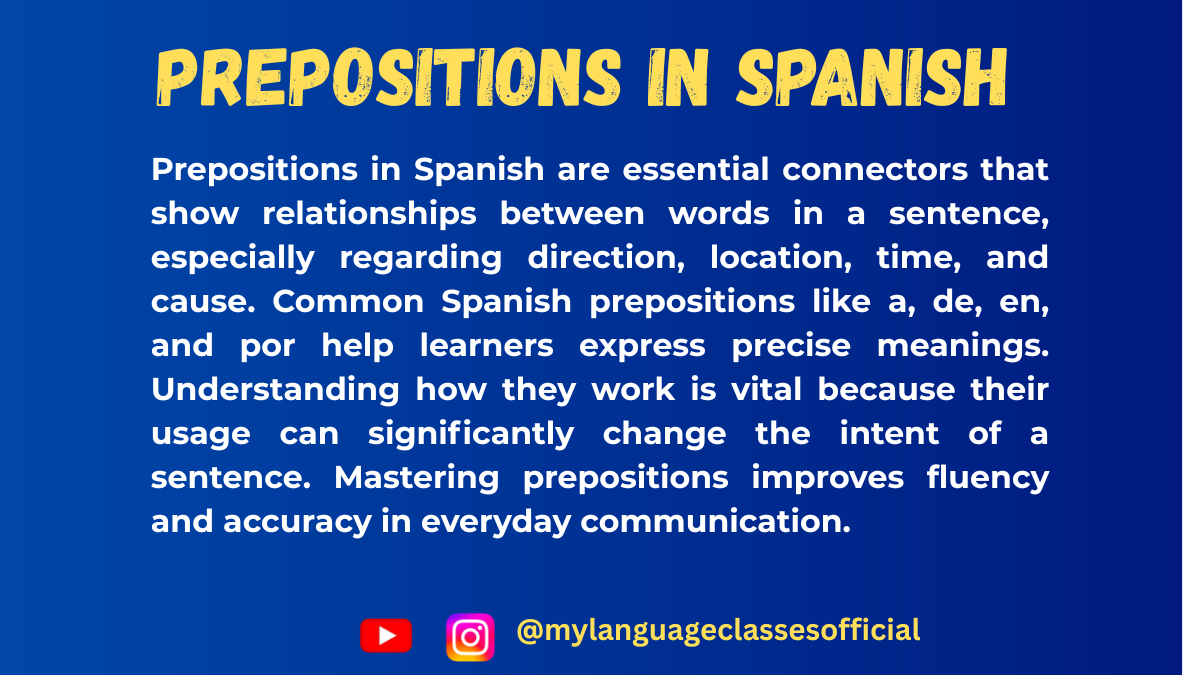
Mastering Prepositions in Spanish
Learning Spanish prepositions can seem tricky at first, but they’re essential for mastering the language. Prepositions are words that establish relationships between elements in a sentence, such as place, time, or cause. In this post, we’ll explore prepositions of place, prepositions of time, and other key types of prepositions in Spanish, with practical examples to enhance your understanding.
1. Prepositions of Place (Preposiciones de lugar)
Prepositions of place indicate the location of an object or person in relation to another. These are some of the most common:
Preposition Meaning Example en in/on/at El libro está en la mesa. (The book is on the table.) sobre on/above La lámpara está sobre la cama. (The lamp is above the bed.) bajo under/below El gato está bajo la silla. (The cat is under the chair.) entre between/among La tienda está entre el banco y la farmacia. (The store is between the bank and the pharmacy.) al lado de next to Mi casa está al lado de la escuela. (My house is next to the school.) frente a in front of El coche está frente a la casa. (The car is in front of the house.) Common Pitfall:
Learners often confuse en (in/on/at) with a (to/at). Remember:
- En emphasizes location (Estoy en casa = “I am at home”).
- A indicates motion or direction (Voy a casa = “I’m going home”).
2. Prepositions of Time (Preposiciones de tiempo)
Prepositions of time indicate when something happens. Here are key examples:
Preposition Meaning Example a at Nos vemos a las cinco. (We’ll see each other at five.) en in/on Nací en marzo. (I was born in March.) desde since/from Trabajo aquí desde 2018. (I’ve worked here since 2018.) hasta until Estaré aquí hasta las tres. (I’ll be here until three.) durante during Fuimos a España durante las vacaciones. (We went to Spain during the holidays.) Note:
The prepositions a and en often cause confusion when talking about time. For instance:
- Use a to refer to specific hours (a las siete = “at seven”).
- Use en for months, years, or periods (en abril = “in April”).
3. Other Common Prepositions
Beyond place and time, prepositions convey various relationships like cause, manner, or possession.
Preposition Meaning Example de of/from/about La casa de Juan es grande. (Juan’s house is big.) por for/because of/by Gracias por tu ayuda. (Thank you for your help.) para for/to/in order to Este regalo es para ti. (This gift is for you.) con with Voy al cine con mis amigos. (I’m going to the movies with my friends.) sin without No salgas sin paraguas. (Don’t go out without an umbrella.) Por vs. Para:
- Por often indicates a reason or means (Lo hice por amor = “I did it out of love”).
- Para suggests purpose or destination (Lo hice para ti = “I did it for you”).
4. How to Master Spanish Prepositions
- Practice with Context: Prepositions often don’t translate directly, so practice them within phrases.
- Memorize with Mnemonics: Use memory aids for tricky pairs like por and para.
- Engage in Real-Life Usage: Try journaling, speaking, or chatting with native speakers to reinforce prepositional phrases.
- Use Visual Aids: Draw diagrams to represent relationships like location (sobre = above, bajo = below).
Conclusion
Understanding and using prepositions correctly is a vital step in becoming fluent in Spanish. While their nuances may seem challenging, consistent practice and exposure will make them second nature. Whether you’re talking about the book on the table (sobre la mesa) or planning a meeting at five (a las cinco), prepositions allow you to express complex ideas with precision.
What are your biggest challenges with Spanish prepositions? Share your experiences in the comments! Let’s learn together. 😊
If you enjoyed this lesson, be sure to check out more posts like this on my blog at My Language Classes. Don’t forget to subscribe my YouTube channel and follow me on Instagram for the latest language learning tips and lessons. Leave a comment below to share your thoughts, or ask any questions you have.
Happy learning! 😊
-
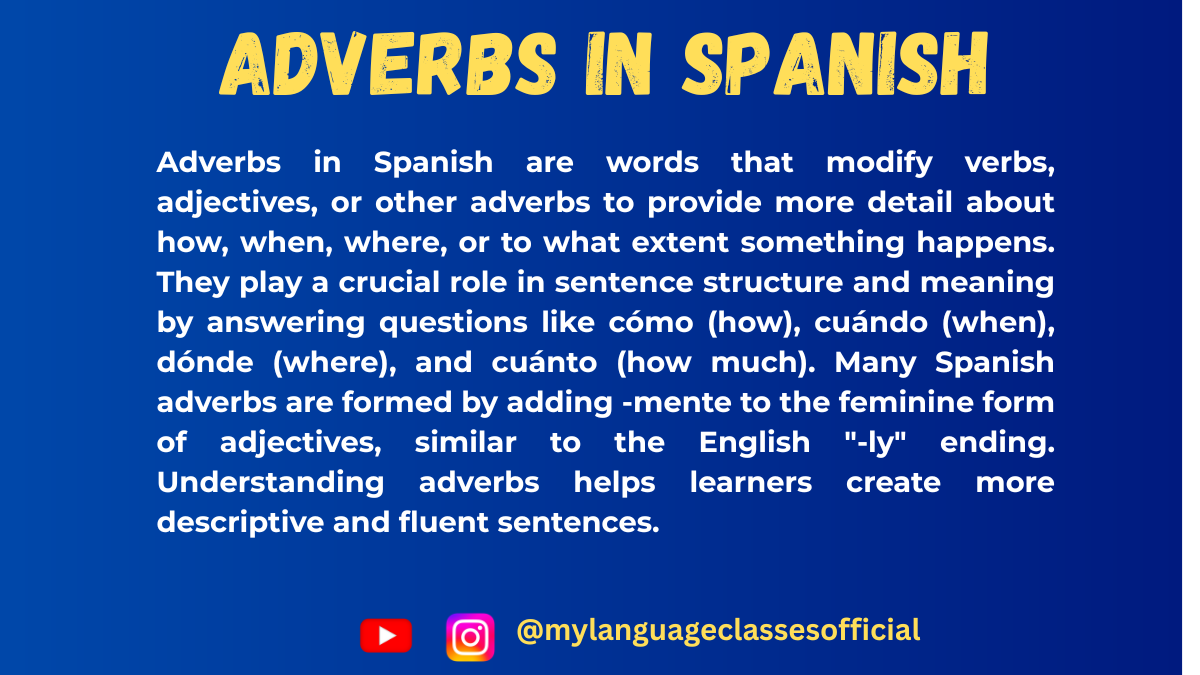
Exploring Spanish Adverbs
Adverbs are essential in Spanish, providing important details about actions—when, where, and how often they happen. Mastering adverbs will help you express yourself more clearly and accurately in everyday conversations. In this blog post, we’ll break down three important types of adverbs: adverbs of frequency, adverbs of time, and adverbs of place. Each type has its own role in enriching your sentences.
1. Adverbs of Frequency: How Often?
Adverbs of frequency tell us how often an action takes place. They are essential for describing habits, routines, and general tendencies in our daily lives. Common adverbs of frequency in Spanish include words like siempre (always) and nunca (never), which are often used to express regularity or lack thereof.
For example:
- Siempre (Always): Yo siempre tomo café por la mañana.
(I always drink coffee in the morning.) - Nunca (Never): Nunca llego tarde al trabajo.
(I never arrive late to work.)
Here’s a table summarizing common adverbs of frequency, their English meanings, and example sentences:
Adverbs of Frequency
Adverb (Spanish) English Meaning Example Sentence (Spanish) Translation (English) Siempre Always Yo siempre tomo café por la mañana. I always drink coffee in the morning. A menudo Often Ellos visitan a sus abuelos a menudo. They often visit their grandparents. Frecuentemente Frequently Los niños frecuentemente juegan en el parque. The children frequently play in the park. A veces Sometimes A veces leo libros en la biblioteca. Sometimes I read books in the library. Rara vez Rarely Ella rara vez come comida rápida. She rarely eats fast food. Nunca Never Nunca llego tarde al trabajo. I never arrive late to work. Tip: In Spanish, adverbs of frequency like siempre and nunca typically come before the verb, while others like a veces and frecuentemente can vary in position for emphasis.
2. Adverbs of Time: When?
Adverbs of time tell us when an action happens. They help us frame the timeline of a conversation, allowing us to specify moments in time—whether something happens right now, in the past, or in the future.
For example:
- Ahora (Now): Estoy estudiando ahora. (I am studying now.)
- Mañana (Tomorrow): Mañana tengo una reunión importante. (Tomorrow I have an important meeting.)
Here’s a table with some common adverbs of time and examples:
Adverbs of Time
Adverb (Spanish) English Meaning Example Sentence (Spanish) Translation (English) Ahora Now Estoy estudiando ahora. I am studying now. Hoy Today Hoy vamos al cine. Today we are going to the cinema. Mañana Tomorrow Mañana tengo una reunión importante. Tomorrow I have an important meeting. Ayer Yesterday Ayer cociné una paella deliciosa. Yesterday I cooked a delicious paella. Tarde Late Llego tarde a la clase de español. I am late for the Spanish class. Temprano Early Siempre llegamos temprano al aeropuerto. We always arrive early at the airport. Tip: When using adverbs of time, be sure to place them where they make the most sense contextually—before or after the verb depending on what you want to emphasize.
3. Adverbs of Place: Where?
Adverbs of place answer the question “Where?” These adverbs describe the location of an action. They are especially helpful in giving directions or providing specific details about where something happens. Common adverbs of place include aquí (here), allí (there), cerca (close), and lejos (far).
For example:
- Aquí (Here): Ven aquí, por favor. (Come here, please.)
- Lejos (Far): Su oficina está lejos de la estación de tren. (Their office is far from the train station.)
Here’s a table summarizing common adverbs of place:
Adverbs of Place
Adverb (Spanish) English Meaning Example Sentence (Spanish) Translation (English) Aquí Here Ven aquí, por favor. Come here, please. Allí There Dejé mis llaves allí. I left my keys there. Cerca Close/Nearby Hay un supermercado cerca de mi casa. There’s a supermarket near my house. Lejos Far Su oficina está lejos de la estación de tren. Their office is far from the train station. Dentro Inside El gato está dentro de la caja. The cat is inside the box. Fuera Outside Los niños juegan fuera. The children play outside. Tip: Adverbs of place often go after the verb, but they can sometimes appear at the beginning of the sentence for emphasis.
Final Thoughts
Adverbs are powerful tools in Spanish that help add context to your sentences. By using adverbs of frequency, adverbs of time, and adverbs of place, you can make your speech or writing much more expressive. Practice using them in different contexts, and soon they will become a natural part of your Spanish communication.
¡Buena suerte en tu aprendizaje! (Good luck with your learning!)
If you enjoyed this lesson, be sure to check out more posts like this on my blog at My Language Classes. Don’t forget to subscribe my YouTube channel and follow me on Instagram for the latest language learning tips and lessons. Leave a comment below to share your thoughts, or ask any questions you have.
Happy learning! 😊
- Siempre (Always): Yo siempre tomo café por la mañana.
-
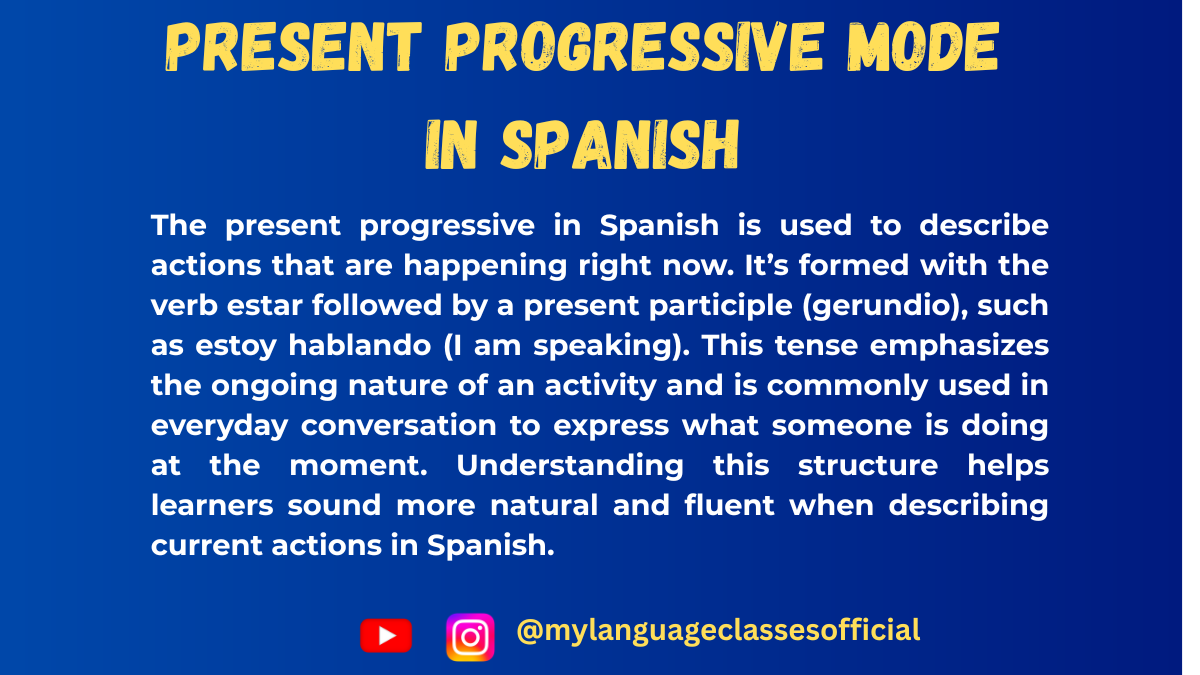
Mastering Present Progressive in Spanish
The present progressive tense (or continuous tense) is one of the most practical and dynamic structures in Spanish. It’s the equivalent of the English “present continuous” tense and is used to describe actions happening right now. If you’ve ever said something like “I am studying” in English, you’ve used a structure similar to Spanish: “Estoy estudiando.”
In this guide, you’ll learn what the present progressive is, how to form it correctly, when to use it, common irregularities, and common mistakes to avoid. Let’s dive in!
What is the Present Progressive?
The present progressive is used to describe actions that are happening right now. It combines the verb estar (to be) as an auxiliary with another verb in its gerund form.
For example:
- Estoy escribiendo (I am writing).
- Estamos aprendiendo español (We are learning Spanish).
How to Form the Present Progressive
1. Conjugate the Verb “Estar”
First, conjugate estar in the present tense according to the subject. Here’s a quick review:
Subject Conjugation of “Estar” Yo estoy Tú estás Él/Ella/Usted está Nosotros/as estamos Vosotros/as estáis Ellos/Ellas/Ustedes están 2. Add the Gerund Form of the Main Verb
The gerund (or present participle) is formed by adding -ando to the stem of -ar verbs and -iendo to the stem of -er and -ir verbs.
Verb Type Example Verb Gerund Form Example -AR Hablar Hablando Estoy hablando (I am speaking). -ER Comer Comiendo Estás comiendo (You are eating). -IR Vivir Viviendo Ellos están viviendo (They are living).
Irregularities in Present Progressive Formation
While most verbs follow the standard -ando/-iendo pattern, some verbs have irregular gerund forms. These can be categorized based on their unique characteristics:
1. Verbs with Spelling Changes
Some verbs change spelling in the gerund to maintain proper pronunciation or avoid awkward letter combinations.
Verb Gerund Form Example Leer Leyendo Estoy leyendo (I am reading). Construir Construyendo Están construyendo (They are building). Oír Oyendo Está oyendo (He/She is hearing). Caer Cayendo Estoy cayendo (I am falling).
2. Stem-Changing Verbs in -IR
Stem-changing verbs that end in -ir modify their stem vowel in the gerund form. These changes occur in verbs that have e → i or o → u shifts in the present tense.
Verb Gerund Form Example Dormir Durmiendo Estoy durmiendo (I am sleeping). Morir Muriendo Está muriendo (He/She is dying). Servir Sirviendo Están sirviendo (They are serving). Pedir Pidiendo Estoy pidiendo (I am requesting).
3. Irregular Verbs with Unique Forms
Certain highly irregular verbs have gerunds that do not follow standard rules.
Verb Gerund Form Example Ir Yendo Estoy yendo (I am going). Poder Pudiendo Está pudiendo (He/She is able to). Venir Viniendo Estamos viniendo (We are coming).
When to Use the Present Progressive
Use the present progressive when describing actions that are happening right now or in the immediate present. Examples include:
- ¿Qué estás haciendo? (What are you doing?)
- Estoy estudiando para un examen. (I am studying for a test.)
- Estamos trabajando en un proyecto. (We are working on a project.)
Common Mistakes to Avoid
- Overusing the Present Progressive In Spanish, the simple present tense is often used instead of the present progressive for habitual actions or near-future events. For example:
- English: I am going to the store tomorrow.
- Correct Spanish: Voy a la tienda mañana. (Not Estoy yendo a la tienda mañana.)
- Incorrect Gerund Formation Remember the spelling and stem changes discussed above. For example:
- Incorrect: Están leiendo.
- Correct: Están leyendo.
- Forgetting to Conjugate “Estar” Always ensure that estar matches the subject of the sentence. For example:
- Incorrect: Ellos está comiendo.
- Correct: Ellos están comiendo.
Practice Exercises
Try these sentences and check your understanding:
- I am listening to music. → (Translate to Spanish)
- We are running in the park. → (Translate to Spanish)
- What are you writing? → (Translate to Spanish)
Conclusion
The present progressive is an essential tool for Spanish learners, especially when you want to describe ongoing actions. By mastering estar + gerundio and learning how to handle irregular verbs, you’ll speak Spanish with greater fluency and confidence. Practice regularly, and don’t be afraid to make mistakes—they are part of the learning process!
¿Qué estás esperando? (What are you waiting for?) Start using the present progressive in your Spanish conversations today!
-
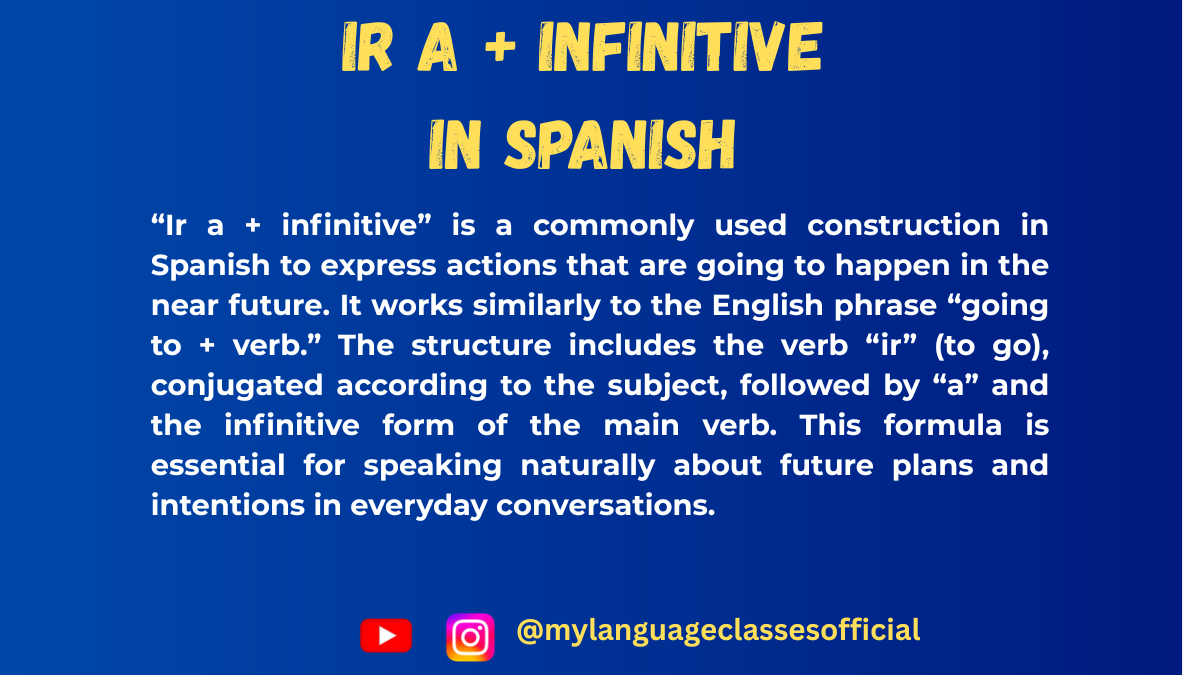
Near Future Tense in Spanish: Mastering Ir a + Infinitive
If you’re learning Spanish, you’ve likely encountered the phrase voy a estudiar (“I’m going to study”). This construction is an example of the near future tense, a simple and versatile way to talk about events that are going to happen soon. Today, we’ll explore how to use this tense, why it’s so practical, and how it compares to other future forms in Spanish. Let’s dive in!
What is the Near Future Tense?
The near future tense in Spanish uses the verb ir (to go), followed by the preposition a and an infinitive verb. It’s similar to the English construction “to be going to + verb.” For example:
- Voy a bailar. – I’m going to dance.
- Vamos a comer. – We’re going to eat.
- Ellos van a viajar. – They’re going to travel.
This structure is widely used in everyday conversation because it’s straightforward and easy to learn.
How to Form the Near Future Tense
The formula is simple:
[Conjugated form of ir] + a + [infinitive verb]Here’s how you conjugate ir in the present tense:
Subject Pronoun Conjugation of ir Yo voy Tú vas Él/Ella/Usted va Nosotros/as vamos Vosotros/as vais Ellos/Ellas/Ustedes van Once you’ve got ir conjugated, just add a and any infinitive verb:
- Voy a leer. – I’m going to read.
- ¿Vas a escribir? – Are you going to write?
- Ellos van a salir. – They are going to go out.
Why Use the Near Future Tense?
The ir a + infinitive construction is perfect for beginners because it’s less complicated than the simple future tense (hablaré, comerás, vivirán). It’s also highly practical—it allows you to talk about immediate plans or intentions without needing to learn additional verb conjugations.
For example:
- Instead of saying Estudiaré mañana (I will study tomorrow), you can say Voy a estudiar mañana (I’m going to study tomorrow).
- Both are correct, but voy a estudiar feels more conversational and is commonly used in informal settings.
Examples of Near Future in Everyday Situations
- Making Plans
- ¿Qué vas a hacer esta tarde? – What are you going to do this afternoon?
- Voy a ir al cine. – I’m going to go to the movies.
- Expressing Intentions
- Vamos a aprender mucho hoy. – We’re going to learn a lot today.
- Voy a ayudar a mi mamá. – I’m going to help my mom.
- Asking Questions
- ¿Vas a venir a la fiesta? – Are you going to come to the party?
- ¿Van a preparar la cena? – Are they going to prepare dinner?
Tips for Mastering the Near Future Tense
- Practice with Everyday Activities: Make a list of what you’re planning to do tomorrow and describe it using ir a + infinitive. For example, Voy a trabajar. Voy a estudiar. Voy a descansar.
- Combine with Time Expressions: Adding time markers helps specify when the action will happen. For example:
- Voy a salir mañana. – I’m going to go out tomorrow.
- Vamos a viajar en verano. – We’re going to travel in summer.
- Roleplay Common Scenarios: Imagine planning a weekend trip, a day at work, or a family gathering. Use phrases like Voy a comprar comida (I’m going to buy food) or Vamos a visitar a nuestros amigos (We’re going to visit our friends).
Comparison with the Simple Future
While the ir a + infinitive construction is easy and practical, the simple future tense (-é, -ás, -á, -emos, -éis, -án) is also important to learn for more formal or distant future events. For example:
- Voy a estudiar español. – I’m going to study Spanish (soon or in the near future).
- Estudiaré español en la universidad. – I will study Spanish at university (a more formal or distant future).
Conclusion
The ir a + infinitive construction is an essential tool for Spanish learners. It’s simple, flexible, and widely used in real-life conversations. By mastering this tense, you’ll be able to express your plans and intentions with confidence.
So, what are you going to do next? (¿Qué vas a hacer ahora?) Practice using this tense, and you’ll see how quickly it becomes a natural part of your Spanish conversations.
¡Buena suerte! 📝
If you enjoyed this lesson, be sure to check out more posts like this on my blog at My Language Classes. Don’t forget to subscribe my YouTube channel and follow me on Instagram for the latest language learning tips and lessons. Leave a comment below to share your thoughts, or ask any questions you have.
Happy learning! 😊
-

Learn How to Use Gustar and Similar Spanish Verbs
When learning Spanish, one of the trickiest yet most fascinating parts of the language is understanding how verbs like gustar work. These verbs don’t follow the typical subject-verb-object structure we’re used to in English. Instead, they flip the script—placing the person or thing we like (or love, or find interesting) at the forefront of the sentence. In this blog post, we’ll break down gustar and similar verbs like encantar and interesar so you can use them like a native speaker.
Understanding the Structure of Gustar
Let’s start with the basics. The verb gustar translates to “to like,” but it literally means “to be pleasing to.” This difference in meaning is key to mastering it. Here’s how it works:
- Indirect object pronoun + verb + subject.
- Me gusta el chocolate. (Chocolate is pleasing to me.)
- Nos gustan los libros. (The books are pleasing to us.)
- El libro me gusta. (singular)
- Los libros me gustan. (plural)
Indirect Object Pronouns
The indirect object pronouns are essential in these constructions because they indicate to whom something is pleasing:
Pronoun English Equivalent Me To me Te To you (informal) Le To him/her/you (formal) Nos To us Os To you all (informal, Spain) Les To them/you all For example:
- Te gusta bailar. (Dancing is pleasing to you.)
- Les gustan las películas. (The movies are pleasing to them.)
Expanding Beyond Gustar: Encantar and Interesar
Now that you’ve got the hang of gustar, you can easily apply this structure to similar verbs like encantar (to love), interesar (to be interested in), and others.
Encantar (To Love)
Use encantar to express stronger emotions, like loving something (but not romantically):
- Me encanta la música clásica. (I love classical music.)
- ¿Te encantan los animales? (Do you love animals?)
Interesar (To Be Interested In)
Use interesar to talk about interests or curiosities:
- Nos interesa la historia. (We are interested in history.)
- ¿Te interesan los deportes? (Are you interested in sports?)
Other Verbs Like Gustar
Here’s a quick list of other verbs that follow the same pattern:
- Fascinar: to fascinate
- Le fascinan los aviones. (Airplanes fascinate him/her.)
- Molestar: to bother
- Nos molesta el ruido. (The noise bothers us.)
- Importar: to matter, to be important
- ¿Te importa si abro la ventana? (Do you mind if I open the window?)
- Quedar: to have left
- Me quedan cinco dólares. (I have five dollars left.)
Common Mistakes to Avoid
- Using the wrong pronoun: Always match the indirect object pronoun with the person who feels the emotion, not the subject.
- Incorrect: Yo gusto los perros. (This means I am pleasing to dogs.)
- Correct: Me gustan los perros. (I like dogs.)
- Forgetting verb agreement: Make sure the verb matches the subject in number.
- Incorrect: Me gusta los libros.
- Correct: Me gustan los libros. (I like the books.)
- Literal translations: Remember, gustar doesn’t mean “to like” in a direct way. Think of it as “to be pleasing to” to grasp the Spanish logic.
Practice Makes Perfect
Here are some sentences for you to practice. Fill in the blanks with the correct form of the verb and pronoun:
- A mí _______ (encantar) las flores en primavera.
- ¿A ti _______ (interesar) el arte moderno?
- A ellos no _______ (gustar) la comida picante.
- A nosotros _______ (molestar) el ruido de la calle.
Final Thoughts
Verbs like gustar give Spanish its charm and unique flair. By understanding their structure and practicing regularly, you’ll unlock a whole new way of expressing yourself. Don’t be afraid to make mistakes—language learning is all about experimenting. ¡Buena suerte!
What’s your favorite gustar-style verb? Share your examples in the comments below!
If you enjoyed this lesson, be sure to check out more posts like this on my blog at My Language Classes. Don’t forget to subscribe my YouTube channel and follow me on Instagram for the latest language learning tips and lessons. Leave a comment below to share your thoughts, or ask any questions you have.
Happy learning! 😊
- Indirect object pronoun + verb + subject.
-
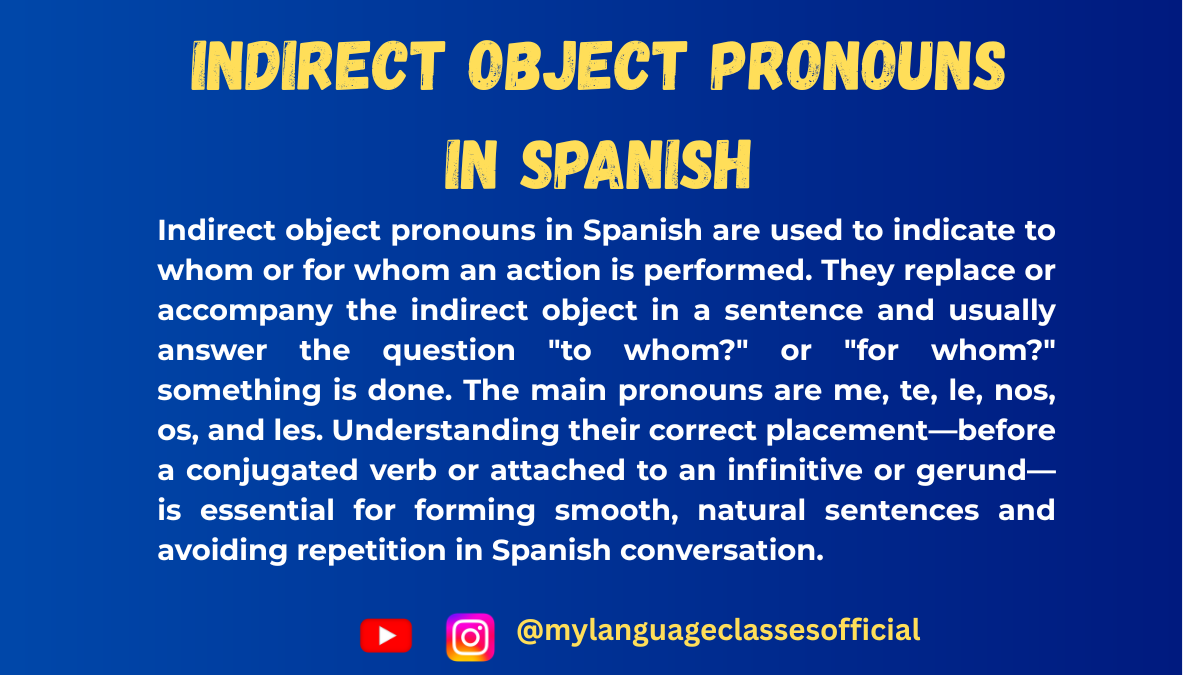
Mastering Indirect Object Pronouns in Spanish
When learning Spanish, understanding indirect object pronouns (pronombres de objeto indirecto) is essential to achieving fluency. These little words pack a big punch, streamlining sentences and helping you sound more natural. In this blog post, we’ll dive into their forms, usage, and provide plenty of examples to solidify your understanding.
What Are Indirect Object Pronouns?
Indirect object pronouns answer the question “To whom?” or “For whom?” an action is performed. They replace the indirect object in a sentence, often saving time and avoiding repetition.
In English:
- He gave her the book.
The pronoun “her” replaces the indirect object (to whom the book was given).
In Spanish:
- Él le dio el libro.
The Indirect Object Pronouns in Spanish
Here are the indirect object pronouns in Spanish:
Pronoun English Equivalent me to/for me te to/for you (informal) le to/for him, her, you (formal) nos to/for us os to/for you (informal plural, used in Spain) les to/for them, you all
Placement of Indirect Object Pronouns
The placement of indirect object pronouns depends on the verb tense and type of verb construction.
1. Before a Conjugated Verb
The indirect object pronoun comes before a conjugated verb.
- María me dio un regalo.
(María gave me a gift.) - ¿Te mandaron la invitación?
(Did they send you the invitation?)
2. Attached to an Infinitive or Gerund
When there’s an infinitive (-ar, -er, -ir) or a gerund (-ando, -iendo), the pronoun can be attached to the verb or placed before the conjugated verb.
- Voy a contarte una historia.
(I’m going to tell you a story.) - Te voy a contar una historia.
(I’m going to tell you a story.) - Estamos escribiéndoles una carta.
(We’re writing them a letter.) - Les estamos escribiendo una carta.
(We’re writing them a letter.)
3. With Commands
- Affirmative commands: Attach the pronoun to the verb.
Dale el libro. (Give him the book.) - Negative commands: Place the pronoun before the verb.
No le des el libro. (Don’t give him the book.)
Indirect Object Pronouns with Clarification
Sometimes, indirect object pronouns like le and les can be ambiguous (they could refer to him, her, it, or them). To clarify, Spanish uses the preposition “a” followed by the indirect object.
- Él le dio un regalo a María.
(He gave a gift to María.)
Even when it’s clear, native speakers often include this redundancy for emphasis:
- A mí me encanta el chocolate.
(I love chocolate.)
The Double Object Pronoun Rule
In Spanish, you can use both a direct object pronoun and an indirect object pronoun in the same sentence. However, when both pronouns begin with “l” (le or les), the indirect object pronoun changes to se.
- Él le dio el libro a María. → Él se lo dio.
(He gave it to her.)
This rule avoids awkward repetition of sounds like “le lo”.
- ¿Les diste la carta? → ¿Se la diste?
(Did you give it to them?)
Practical Tips for Mastery
- Practice Common Verbs: Some verbs are frequently used with indirect object pronouns, such as dar (to give), decir (to say), preguntar (to ask), and gustar (to like).
Example:- ¿Me das tu número de teléfono? (Can you give me your phone number?)
- A ellos les gusta bailar. (They like dancing.)
- Immerse Yourself: Watch movies or read books in Spanish, paying attention to how these pronouns are used.
- Drill Sentence Structures: Write or say sentences with and without the pronouns to see the difference.
Exercises for Practice
- Rewrite the sentences using indirect object pronouns:
a) Yo di flores a mi mamá.
b) Estamos escribiendo una carta a nuestros amigos.
c) Juan va a dar el regalo a ti. - Translate into Spanish:
a) She told him the truth.
b) They bought us a souvenir.
c) I am going to explain the problem to you.
Final Thoughts
Mastering indirect object pronouns is a stepping stone toward fluency in Spanish. With practice and immersion, they’ll soon feel like second nature. Remember to focus on placement, usage rules, and practice as much as possible in real-life scenarios. ¡Buena suerte!
Have questions or want more practice? Drop them in the comments below!
If you enjoyed this lesson, be sure to check out more posts like this on my blog at My Language Classes. Don’t forget to subscribe my YouTube channel and follow me on Instagram for the latest language learning tips and lessons. Leave a comment below to share your thoughts, or ask any questions you have.
Happy learning! 😊
- He gave her the book.
-
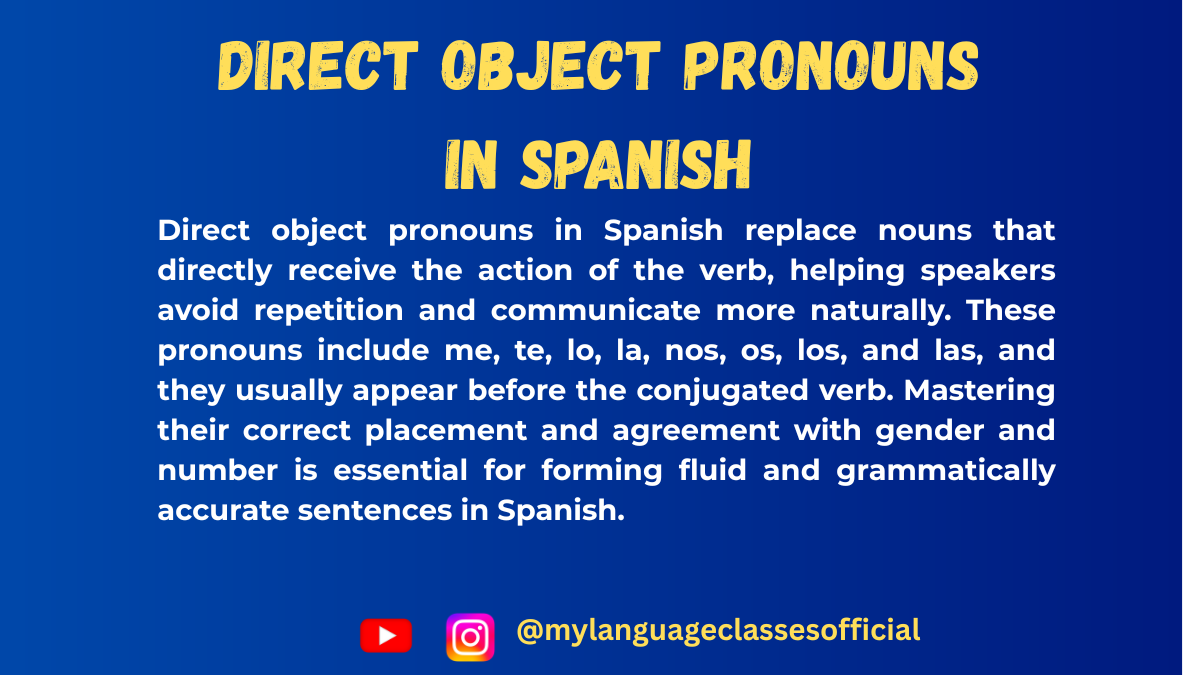
Mastering Direct Object Pronouns in Spanish
When learning Spanish, one of the most essential skills is understanding how to use direct object pronouns. These little words can simplify your sentences and make your speech sound more fluid and natural. In this blog, we’ll explore what direct object pronouns are, how they’re used, and provide plenty of examples to help you master them.
What Are Direct Object Pronouns?
A direct object in a sentence answers the questions “what?” or “whom?” about the verb. For example:
- I see the book. (What do I see? The book.)
- She calls her friend. (Whom does she call? Her friend.)
In Spanish, instead of repeating the noun (like “the book” or “her friend”), we replace it with a direct object pronoun.
The Direct Object Pronouns in Spanish
Here’s a handy table of direct object pronouns:
Pronoun English Meaning Me Me Te You (informal) Lo Him/It (masculine) La Her/It (feminine) Nos Us Os You all (informal, Spain) Los Them (masculine/mixed) Las Them (feminine)
Placement of Direct Object Pronouns
In Spanish, the placement of direct object pronouns can seem tricky at first, but there are clear rules:
- Before a Conjugated Verb
- Example:
- Yo veo el carro. (I see the car.) → Yo lo veo. (I see it.)
- Ella compra las flores. (She buys the flowers.) → Ella las compra. (She buys them.)
- Example:
- Attached to an Infinitive
- Example:
- Voy a llamar a María. (I am going to call María.) → Voy a llamarla. (I am going to call her.)
- Example:
- Attached to a Present Participle
- Example:
- Estoy leyendo el libro. (I am reading the book.) → Estoy leyéndolo. (I am reading it.)
- Note: Add an accent to maintain proper stress when attaching the pronoun.
- Example:
- Attached to an Affirmative Command
- Example:
- Compra el pan. (Buy the bread.) → Cómpralo. (Buy it.)
- Note: Add an accent when necessary to preserve the original stress.
- Example:
Examples in Action
Here are some real-life scenarios where direct object pronouns are used:
Simple Sentences
- ¿Tienes el dinero? (Do you have the money?)
→ Sí, lo tengo. (Yes, I have it.) - ¿Conoces a Ana? (Do you know Ana?)
→ Sí, la conozco. (Yes, I know her.)
Questions and Negatives
- ¿Estás mirando la televisión? (Are you watching the TV?)
→ No, no la estoy mirando. (No, I’m not watching it.)
Infinitives
- ¿Vas a ver la película? (Are you going to watch the movie?)
→ Sí, voy a verla. (Yes, I’m going to watch it.)
Commands
- Escribe la carta. (Write the letter.)
→ Escríbela. (Write it.)
Common Errors to Avoid
- Confusing Direct and Indirect Object Pronouns
Remember, direct object pronouns answer “what?” or “whom?”, while indirect object pronouns answer “to whom?” or “for whom?”Example:- Direct: Lo veo. (I see him.)
- Indirect: Le hablo. (I speak to him.)
- Forgetting to Match Gender and Number
Make sure the pronoun matches the noun in gender and number. For example:- Las cartas (the letters) → las
- El carro (the car) → lo
- Misplacing Pronouns
Incorrect: Voy llamarla.
Correct: Voy a llamarla or La voy a llamar.
Practice Time!
Let’s put your skills to the test. Try replacing the direct object with a pronoun in the following sentences:
- Yo compro las manzanas.
- Nosotros vemos a Juan.
- María está leyendo el libro.
- ¿Has visto a tus amigos?
- Compra los billetes.
Answers
- Yo las compro.
- Nosotros lo vemos.
- María está leyéndolo.
- ¿Los has visto?
- Cómpralos.
Final Thoughts
Direct object pronouns are a powerful tool to make your Spanish more efficient and natural. With practice, using them will become second nature. Start incorporating them into your conversations today—you’ve got this!
Keep practicing, and soon you’ll sound like a native! 😊
If you enjoyed this lesson, be sure to check out more posts like this on my blog at My Language Classes. Don’t forget to subscribe my YouTube channel and follow me on Instagram for the latest language learning tips and lessons. Leave a comment below to share your thoughts, or ask any questions you have.
Happy learning! 😊
-

Reflexive Verbs in Spanish
¡Hola, amigos! Welcome back to My Spanish Class, your go-to blog for learning Spanish the fun and effective way. In today’s post, we’re diving into one of the most essential and fascinating aspects of Spanish grammar: reflexive verbs. Whether you’re a beginner or brushing up on your skills, this guide has you covered.
What Are Reflexive Verbs?
In Spanish, a reflexive verb indicates that the subject of the sentence is also the receiver of the action. In simpler terms, the action reflects back on the subject. Reflexive verbs are commonly used for daily routines, emotions, and actions related to oneself.
For example:
- Me baño (I bathe myself).
- Se despierta (He/She wakes up).
The key to identifying reflexive verbs is the reflexive pronoun (me, te, se, nos, os, se) and the verb ending in -se in its infinitive form, like bañarse (to bathe oneself).
How to Form Reflexive Verbs
Reflexive verbs are formed by combining the reflexive pronoun with the correct conjugation of the verb. Here’s a step-by-step guide:
- Start with the infinitive: For example, levantarse (to get up).
- Remove the -se: You’re left with the verb root, levantar.
- Conjugate the verb: Conjugate the verb as you normally would for the subject.
- Add the reflexive pronoun: Place the appropriate reflexive pronoun (me, te, se, nos, os, se) before the conjugated verb.
Here’s the breakdown for levantarse in the present tense:
Subject Reflexive Pronoun Verb Form Result Yo me levanto Me levanto Tú te levantas Te levantas Él/Ella/Usted se levanta Se levanta Nosotros nos levantamos Nos levantamos Vosotros os levantáis Os levantáis Ellos/Ellas/Ustedes se levantan Se levantan
Reflexive Pronouns
Here’s a quick table of reflexive pronouns in Spanish:
Subject Reflexive Pronoun Yo me Tú te Él/Ella/Usted se Nosotros nos Vosotros os Ellos/Ellas/Ustedes se
Commonly Used Reflexive Verbs
Here’s a list of reflexive verbs that you’ll encounter frequently:
- Daily Routines
- Despertarse (to wake up)
- Levantarse (to get up)
- Vestirse (to get dressed)
- Lavarse (to wash oneself)
- Cepillarse (to brush, e.g., teeth or hair)
- Peinarse (to comb one’s hair)
- Maquillarse (to put on makeup)
- Bañarse (to bathe oneself)
- Ducharse (to shower oneself)
- Emotions and States
- Enojarse (to get angry)
- Alegrarse (to get happy)
- Preocuparse (to worry)
- Sentirse (to feel)
- Calmarse (to calm down)
- Social and Interpersonal Actions
- Casarse (to get married)
- Divertirse (to have fun)
- Despedirse (to say goodbye)
- Quedarse (to stay)
- Aburrirse (to get bored)
Conjugation Table Example: Despertarse
Let’s take the verb despertarse (to wake up) as an example and conjugate it in the present tense:
Subject Reflexive Pronoun Verb Conjugation Result Yo me despierto Me despierto Tú te despiertas Te despiertas Él/Ella/Usted se despierta Se despierta Nosotros nos despertamos Nos despertamos Vosotros os despertáis Os despertáis Ellos/Ellas/Ustedes se despiertan Se despiertan Here are some example sentences using reflexive verbs in Spanish, along with their English translations. These examples cover different contexts such as daily routines, emotions, and social actions:
Daily Routines
- Me despierto a las seis de la mañana.
(I wake up at six in the morning.) - Después de despertarme, me levanto inmediatamente.
(After waking up, I get up immediately.) - Se cepilla los dientes tres veces al día.
(He/She brushes their teeth three times a day.) - Nos duchamos después de hacer ejercicio.
(We shower after exercising.) - ¿Te peinas el cabello todos los días?
(Do you comb your hair every day?)
Emotions and States
- Me siento muy feliz hoy.
(I feel very happy today.) - ¿Te preocupas mucho por los exámenes?
(Do you worry a lot about exams?) - Se enoja cuando alguien llega tarde.
(He/She gets angry when someone arrives late.) - Nos calmamos después de hablar con el profesor.
(We calmed down after talking to the teacher.) - Ellos se aburren en las clases largas.
(They get bored in long classes.)
Social and Interpersonal Actions
- Me caso con mi pareja el próximo mes.
(I’m getting married to my partner next month.) - Nos despedimos de nuestros amigos en la estación de tren.
(We said goodbye to our friends at the train station.) - Se divierten mucho en las fiestas.
(They have a lot of fun at parties.) - Te quedas en casa cuando llueve mucho, ¿verdad?
(You stay home when it rains a lot, right?) - Me arrepiento de no haber estudiado más para el examen.
(I regret not having studied more for the exam.)
Reflexive vs. Non-Reflexive Verbs
Some verbs can be used reflexively or non-reflexively depending on the meaning. Here are examples to show the difference:
Reflexive: Me lavo las manos antes de comer.
(I wash my hands before eating.)Non-Reflexive: Lavo los platos después de la cena.
(I wash the dishes after dinner.)Reflexive: Se despierta temprano los fines de semana.
(He/She wakes up early on weekends.)Non-Reflexive: El ruido despierta al bebé.
(The noise wakes up the baby.)
Practice these sentences by writing and speaking them aloud to get comfortable with reflexive verbs in various contexts.
Tips for Learning Reflexive Verbs
- Practice Daily Routines: Write out your morning or evening routine using reflexive verbs.
- Watch Spanish Videos: Look for content on YouTube (like my channel 😉) that uses reflexive verbs in context.
- Memorize Reflexive Pronouns: These are your best friends when working with reflexive verbs.
- Conjugation Drills: Create a table of conjugations and practice until they’re second nature.
Final Thoughts
Learning reflexive verbs might seem tricky at first, but with practice, they’ll become a natural part of your Spanish vocabulary. Remember, reflexive verbs add richness to your conversations, letting you describe actions that involve yourself or your feelings.
If you enjoyed this lesson, be sure to check out more posts like this on my blog at My Language Classes. Don’t forget to subscribe my YouTube channel and follow me on Instagram for the latest language learning tips and lessons. Leave a comment below to share your thoughts, or ask any questions you have.
Happy learning! 😊
